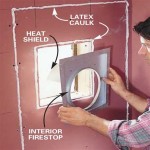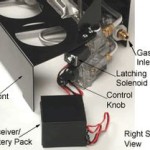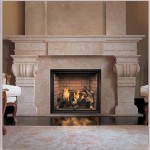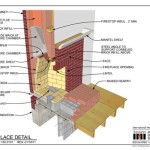Concealing Television Cords on a Brick Fireplace: A Comprehensive Guide
Mounting a television above a brick fireplace is a popular aesthetic choice, offering a focal point and entertainment center within a living space. However, the exposed cords detract from the clean, sophisticated look most homeowners aim to achieve. Successfully hiding television cords on a brick fireplace presents unique challenges compared to drywall installations. The rigid and often uneven surface of brick requires specific techniques and tools to conceal wiring effectively and safely. This article provides a detailed guide to various methods for managing and concealing television cords on a brick fireplace, ensuring a visually appealing and functionally sound entertainment setup.
Understanding the Challenges of Brick
Brick, unlike drywall, is a solid and non-porous material. This means traditional methods of running wires behind the wall are not applicable. Drilling into brick requires specialized tools and techniques to avoid damage to the brick itself or the structural integrity of the fireplace. Furthermore, the mortar joints between bricks, while seemingly providing convenient channels, are often irregular and may not accommodate the thickness of multiple cords. The texture and color variations of brick also make it more difficult to seamlessly blend concealment solutions. Therefore, choosing the right method requires careful consideration of the fireplace's construction, cord volume, and desired aesthetic outcome.
External Cord Concealment Solutions
External cord concealment options provide a straightforward approach to hiding television cords without requiring extensive modification of the brick. These methods involve using surface-mounted channels or covers to route the cords from the television to the power outlet and other connected devices. The key to a successful external concealment strategy is to choose materials that blend with the brick's color and texture, minimizing their visual impact.
One common solution is the use of paintable cord covers. These are typically made of plastic or PVC and can be cut to the desired length and painted to match the brick or mortar. They are attached to the brick using adhesive strips, screws, or a combination of both. Adhesive strips are suitable for lighter cords and smooth brick surfaces, while screws provide a more secure attachment for heavier cords or uneven surfaces. When using screws, it is essential to drill pilot holes into the mortar joints to avoid damaging the brick itself. The cords are then placed inside the channel and the cover is snapped or screwed into place.
Another option is to use cord concealer kits specifically designed for brick surfaces. These kits often include a variety of connectors and fittings, allowing for flexible routing of cords around corners and along the fireplace. Some kits also incorporate texture to better mimic the appearance of brick. These kits typically employ a combination of adhesive and mechanical fasteners for secure mounting.
Fabric cord covers represent a softer, more flexible approach. These covers are made of fabric and often feature a zipper or Velcro closure. They are available in a variety of colors and textures, allowing for greater customization. While not as durable as plastic or PVC cord covers, fabric covers can effectively conceal cords and add a decorative element to the fireplace. Because of the material, this option is recommended for low-traffic areas or where the cover is not likely to be disturbed. Securing the fabric cord cover may require the use of small adhesive clips or tacks applied to the mortar joints.
When selecting an external cord concealment solution, it is crucial to measure the cords to be concealed accurately. Choosing a channel or cover that is too small can result in bulging or difficulty closing the cover. A larger channel is preferable to ensure the cords are not compressed or damaged. Consider future needs and potential additions to the home entertainment system, choosing a channel that can accommodate additional cords as needed.
Internal Cord Concealment Solutions (Partial)
While completely concealing cords within a brick fireplace is challenging and often not recommended due to the structural implications, a partial internal concealment approach can be employed to minimize the visible cord length. This typically involves running the cords through a small section of the wall cavity behind the television and then transitioning to an external concealment solution to reach the power outlet and other devices.
This method requires drilling a hole through the brick or mortar to access the wall cavity. This should be performed with extreme caution and only by individuals with experience in working with brick. A masonry drill bit and a hammer drill are necessary to create a clean, precise hole. The size of the hole should be large enough to accommodate the cords but small enough to be easily concealed if the internal route is later abandoned. Proper safety precautions, including wearing eye protection and a dust mask, are essential when drilling into brick.
Once the hole is drilled, a wire fishing tool can be used to guide the cords through the wall cavity. If the wall cavity is insulated, it may be necessary to remove some insulation to create a clear path for the cords. A flexible conduit can be used to protect the cords within the wall cavity and prevent them from rubbing against rough surfaces. The conduit should be secured to the back of the fireplace using adhesive or mechanical fasteners.
The point where the cords exit the wall cavity can be concealed using a decorative wall plate or a paintable cord cover. This transition point should be carefully planned to minimize the visible cord length and create a seamless appearance. The external concealment solution can then be used to route the cords to the power outlet and other devices. It is crucial to ensure that all electrical connections are made by a qualified electrician to ensure safety and compliance with local electrical codes.
The partial internal concealment method offers a cleaner look than purely external solutions, but it requires more effort and expertise. It is important to carefully assess the fireplace's construction and the potential risks before attempting this method. Consider consulting with a professional electrician or contractor to determine the feasibility and safety of this approach.
Decorative Cord Management Techniques
In some cases, fully concealing the cords may not be feasible or desirable. Decorative cord management techniques offer an alternative approach by transforming the cords into a design element. These techniques can involve using decorative sleeves, clips, or other accessories to organize and style the cords, turning them into a visually appealing feature.
Braided cord sleeves offer a stylish and functional way to manage cords. These sleeves are made of fabric or nylon and are available in a variety of colors and patterns. They can be easily wrapped around the cords, creating a neat and organized bundle. Braided cord sleeves not only conceal the cords but also add a touch of texture and color to the fireplace. Securing the braided sleeve may require the use of small adhesive clips or ties along the fire place. It is possible to match the color with the mortar to give the illusion of minimal cord running along the surface.
Decorative cord clips can be used to secure the cords to the brick in a visually appealing way. These clips are available in a variety of designs, from simple and minimalist to ornate and decorative. The clips can be attached to the brick using adhesive or small screws. When using screws, it is important to drill pilot holes into the mortar joints to avoid damaging the brick. Strategic placement of the clips can create a visually interesting pattern or arrangement of the cords.
Another decorative cord management technique is to use the cords to create a specific design or shape. This can involve arranging the cords into a geometric pattern, a whimsical design, or even a representation of a favorite object. This approach requires creativity and planning but can result in a unique and personalized entertainment center. Small, clear adhesive clips can be used to hold the cords in place and maintain the desired shape.
Consider incorporating natural elements into the cord management design. For example, vines or artificial greenery can be used to conceal the cords and add a touch of nature to the fireplace. The vines can be draped over the cords, creating a visually appealing and organic look. Securing the vines may require the use of small wire ties or clips attached to the brick or mortar.
Choosing the right decorative cord management technique depends on the homeowner's personal style and the overall aesthetic of the room. Experiment with different options to find the approach that best complements the fireplace and creates a visually appealing entertainment center.
Safety Considerations
When concealing television cords on a brick fireplace, safety should be the foremost consideration. Improperly installed or managed cords can pose a fire hazard or create a tripping hazard. Following all applicable electrical codes and guidelines is crucial to ensure a safe and functional entertainment setup.
Avoid running cords behind or under flammable materials, such as rugs or furniture. This can trap heat and increase the risk of a fire. Ensure that the cords are properly ventilated and not exposed to excessive heat.
Do not overload electrical outlets or power strips. Overloading can cause the circuit breaker to trip or, in severe cases, start a fire. Use a surge protector to protect the television and other electronic devices from power surges.
Regularly inspect the cords for damage or wear. Replace any damaged cords immediately to prevent electrical shock or fire hazards. Ensure that all cords are properly insulated and grounded.
When drilling into brick, wear appropriate safety gear, including eye protection and a dust mask. Use a hammer drill with a masonry drill bit to create clean, precise holes. Be careful not to damage the brick or the structural integrity of the fireplace.
If unsure about any aspect of the cord concealment process, consult with a qualified electrician or contractor. They can provide expert advice and ensure that the installation is performed safely and in accordance with local electrical codes.

How To Mount A Tv Over Brick Fireplace And Hide The Wires Designing Vibes Interior Design Diy Lifestyle

How To Hide Tv Wires Above A Fireplace When You Can T Go Through The Wall Homes I Have Made

Tv Mounting Over A Brick Fireplace With Wires Concealed In Wire Molding S

How To Build A Diy Mantel That Hides Your Tv Wires Worst On The Block

Mounting A Tv On Brick Above Fireplace House Of Hepworths

How To Hide Tv Wires Over Brick Fireplace Mountyourbox

How To Build A Diy Mantel That Hides Your Tv Wires Worst On The Block

Mounting A Tv On Brick Above Fireplace House Of Hepworths

How To Hide Tv Wires Above A Fireplace When You Can T Go Through The Wall Homes I Have Made

36 Genius Ways To Hide The Eyesores In Your Home Projects House Design








